|
Africa Trip -
September 2010
South Africa - Botswana - Zambia
|
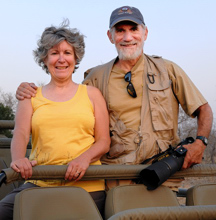 |
|
Africa Trip -
September 2010
South Africa - Botswana - Zambia
|
 |
Botswana - Chobe Camp (9/16-18/2010)
|
|
| The mobile
safari is a great way to see Africa, especially for photography. It
works really well when the distances are short between each camp as our
trip was up to our Khwai Camp. Our tour was set up to really explore the
Okavango Delta area and also the Chobe River area. Geographically, these
two general locations are separated by a large expanse of dry bush area
with very sparse wildlife. So rather than a morning game drive, we left
Khwai Camp early and headed north east on the sandy road to
Chobe
National Park. In
order to cover the distance in the minimum amount of time, the roof
hatches were covered and the windows closed too keep out the dust and
the vehicles plowed along for about 5 hours.
After a picnic lunch along the road around noon, we saw something we hadn't seen in Botswana before, hills. The delta area is very flat and was a bit strange for Linda and I who live in the mountains. As we approached the Savuti area we saw these mounds in the distance that turned out to be large rocky hills. We did a short game drive out to the hills and stopped to explore the prehistoric rock paintings on a cliff face on the side of one of the hills. After that it was back in the vehicles and we drove anothe two hours to Chobe National Park along the Chobe River. We did pass through several villages and even drove beside a new paved road that was being built by Chinese engineers. We finally reached the Chobe entrance gate where we had to go through a insecticide treatment for our shoes to prevent the spread of any diseases into the park. Unlike the Okavango Delta where the water channels are everywhere, the Chobe River is the only source of water at Chobe National Park. This means the animals concentrate along the river and are in much larger herds. The concentration of elephants at Chobe is probably the largest in the world. There is a daily migration pattern that the animals have in the dry season in which they come down to the river en masse in the morning to drink and then late in the morning most of them retreat to the forest to beat the heat under the shade of the larger trees. Late in the afternoon they again come down to drink. Our standard game drive schedule matched this pattern and it was exciting to park down at the river and have large herds of Cape Buffalo, Zebra and Elephant pass by. On one afternnoon we spotted a crimson cloud of birds out on the banks of the river. It turned out to be a large nesting site of Carmine-breasted Bee Eaters. We spent the late afternoon trying to capture the perfect shot of the clouds of birds as they hunted for insects and filled the trees along the river. We also spent time observing and shooting the many African Fish Eagles that plied the river for the many fish there. We saw a few fledgling eagles being fed by their parents. There was also an opportunity to see a new animal we hadn't seen in the delta, the Sable Antelope. A large herd passed right by on one of the morning drives. The best way to fully experience the Chobe area is to get out on the river. On our second day there the group went out on a pontoon boat and cruised up river from the town of Kasane which sits right at the confluence of the Chobe and Zambesi rivers. Shooting animals on the bank from the river gave us a different angle on the wildlife. Elephants, Hippos, Cape Buffalo and crocodiles lined the banks of the river and posed for us as we passed by on the boat. Chobe lived up to its repiutation and we saw more elephants here than anywhere else. We even had a couple of elephants walk right along the edge of our camp. |
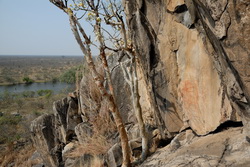 Indigenous rock painting at Savuti 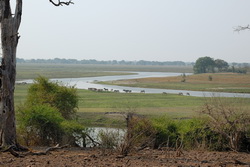 Zebra herd at Chobe river 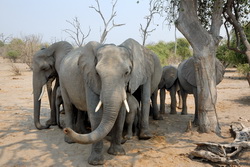 Elephant family group 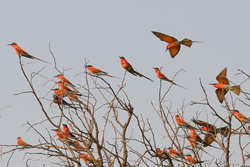 Carmine-breasted Bee Eaters 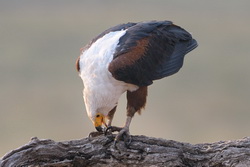 African Fish Eagle 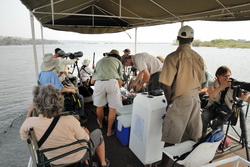 Lunch on the Chobe River 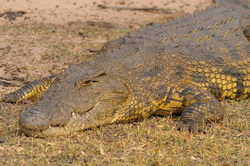 Croc on banks of Chobe River |
| Slideshow |
|
|
|
|
|
|
|
|
|